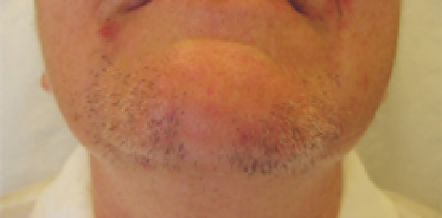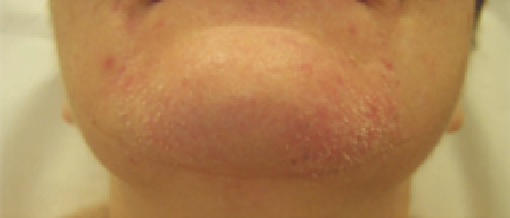Biomedical Engineering Reference
In-Depth Information
Case 8
A 13-year-old girl consulted for improvement of a posttraumatic scar on the lateral part of her thigh. The scar was hypopig-
mented and spread. Because she did not want any major surgical intervention, a noninvasive approach to induce neocollagenesis
was attempted. She received seven treatments at low dose, with a long-pulsed 1064-nm Nd:YAG laser [Lyra, Index (Mountain
View, California, USA)], at 30 ms, 24 J/cm
2
for a 10-mm spot size. After the last treatment, she noticed the appearance of black
terminal hair around the treated scar (Fig. 5.11). Conversion of fi ne vellus hair to dark, coarse terminal hair in the immediate
vicinity of the treatment area had occurred. Currently, she is being treated for hair removal with an 800-nm diode laser at high
dose (12 × 12 mm, 45 J/cm
2
, and 30 ms).
Figure 5.11
Hypertrichosis induced by 1064-nm long-pulsed neodymium-doped:yttrium-aluminum-garnet laser at low fl uence for scar improvement.
Case 9
A 56-year-old postmenopausal woman consulted for hair removal of the hypertrichosis on her chin. This was composed
of 50% dark, coarse terminal hairs and 50% coarse white hairs (Fig. 5.12A). LHR with an 800-nm diode laser (12 × 12 mm,
35 J/cm
2
, and 30 ms) successfully removed the black hairs, but left the white hairs untouched (Fig. 5.12B). Currently, no light-
based techniques are available to induce long-term hair removal of white hairs.
(
A
)
(
B
)
Figure 5.12
(
A
) Postmenopausal patient with hypertrichosis on chin before laser hair removal. (
B
) Pigmented terminal hairs were successfully removed but
white terminal hairs were resistant to treatment.
side effects and management
of complications
LHR was cleared by the US Food and Drug Administration in
l996 and has an excellent safety and effi cacy profi le. Complica-
tions are rare if treatments are done carefully and with the
patient's skin type in mind.
LHR is not a painless procedure. Most patients experience
some discomfort during and immediately after treatment.
A topical or local anesthetic can be used before treatment as
well as cold air cooling before, after, and during treatment to
reduce this effect. Perifollicular erythema and edema are
expected in many patients treated with signifi cant laser fl u-
ences. The intensity and duration depend on hair color and
hair density. This usually lasts a few hours (Fig. 5.3).
Epidermal damage occurs if excessive fl uences are used or in
pigmented skin, so appropriate epidermal cooling techniques are


















